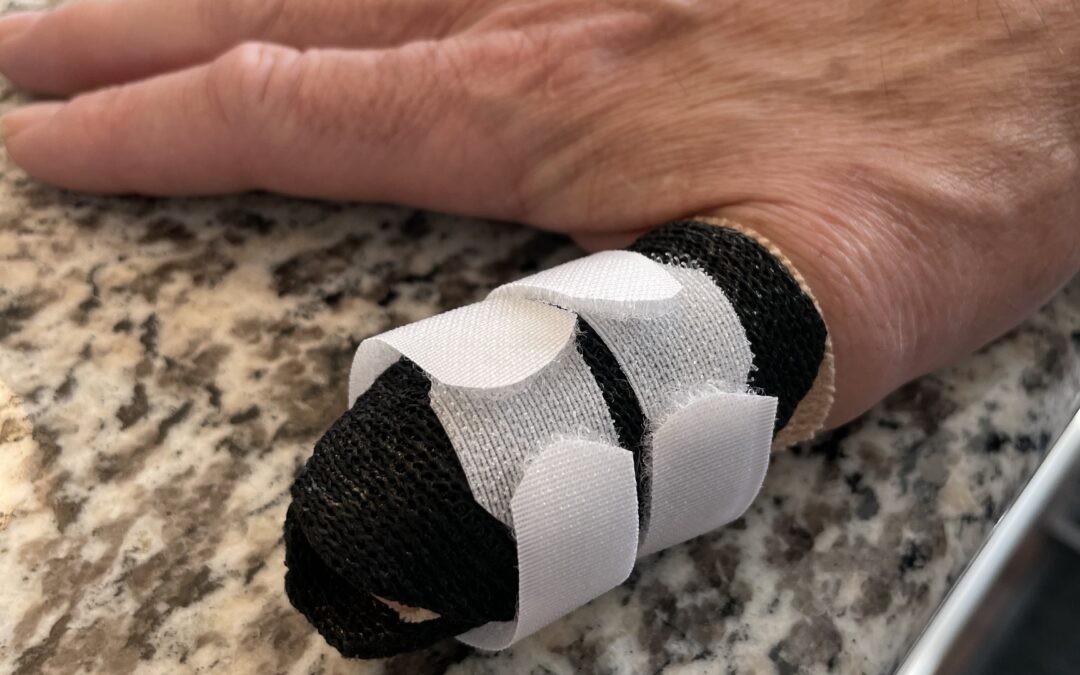A splint or brace is a device used to support or hold a body part still after an injury or surgery.
While the words may be used interchangeably, in general, a brace is meant to support an injured area, while a splint is commonly used to immobilize an injured body part. Sometimes a splint is also called an orthosis.
In hand therapy, we call a custom-made support, often made from rigid plastic which is molded to you, a “splint.” An example would be a splint molded to your thumb to immobilize bones after a fracture.
Hand therapists call an over-the-counter support a “brace.” An example would be a brace to support the joint at the base of your thumb which is painful due to osteoarthritis.
WHY WOULD I USE A SPLINT OR BRACE?
Wrist and hand splints are used to protect and support painful, swollen or weak joints and soft tissues, such as tendons and ligaments. They are designed to make sure you position your wrist and hands correctly.
There are four types of hand or wrist splints:
- splints used for resting joints of the wrist and hand,
- splints used to support work done by the hands,
- splints used to immobilize bones or soft tissues to allow them to heal,
- splints used to increase mobility of stiff joints and soft tissues.
Resting splints or braces
Support your joints and can help to ease pain and inflammation. An example is a wrist support for carpal tunnel syndrome. The splint or brace holds your wrist straight to reduce pressure on the median nerve at the carpal tunnel.
Photo by Tom Claes on Unsplash
A resting splint is intended to:
- reduce wrist and hand pain,
- rest and support your wrist and hand in the correct position,
- help to reduce swelling and morning stiffness.
You may wear your resting splint:
- overnight or occasionally during the day when resting,
- during flare-ups or when you have painful joints,
- as advised by your therapist.
Working splints or braces
Support your wrist and hand joints while you are using your hands. They can be worn when you carry out daily tasks and should make the job less painful. An example is a finger splint designed to support and reduce stress through an arthritic joint.
Or a splint to hold a fishing rod.
A working splint is intended to:
- give your wrist or finger support while carrying out activities that would normally be painful,
- make jobs easier to manage,
- increase your grip strength,
- help protect and support your wrist or finger,
- help reduce or prevent wrist or finger pain.
You may wear your working splint:
- during activities that cause you pain,
- when your wrist or finger is swollen,
- when your wrist or finger feels weak,
- when you’re experiencing more discomfort than usual,
- as advised by your therapist.
Splints or braces to immobilize
Used to treat healing bones or certain soft tissue injuries by preventing unwanted motion. The splint is usually worn constantly or removed only for hygiene or to perform specific exercises.
Mobility splints
Designed to stretch tight tissues. Some splints are worn constantly, such as a splint to improve straightening of the finger.
Others are worn for prescribed amount of time throughout the day, such as a splint to improve finger bending.
WOULD I WEAR MORE THAN ONE SPLINT?
In some cases, you might use two splints, often one for nighttime and one for daytime. Many people have more than one pair of glasses – a pair for reading and one for driving. The same may be true if you wear a splint or brace for your wrist or hand.
During the day, when you need to move more, you may need light support which provides compression without restricting motion. A firm splint for night limits motion and enables the muscles and joints to rest, reducing pain and inflammation. Those who have symptoms of carpal tunnel syndrome often wear a splint that keeps the wrist supported but allows them to use their hand during the day and a brace during sleep to help the tendons and nerves rest.
HOW DO I KNOW WHAT KIND OF SPLINT I NEED?
A hand therapist can help you to determine whether a splint or brace would be beneficial for you. They can also make a custom splint, if that would be best for you. Some braces are available on-line or at a pharmacy. We don’t recommend that you buy braces yourself unless you’ve received advice from your doctor or therapist, so you can be sure the brace is appropriate and effective for you. You also shouldn’t borrow or use other people’s splints, or let them use yours, as they won’t have been designed to suit your needs.
WHERE CAN I FIND A HAND THERAPIST?
A hand therapist is available at North 49 Physical Therapy clinic. You can book online at north49therapy.com or call the clinic at (306) 343-7776.

